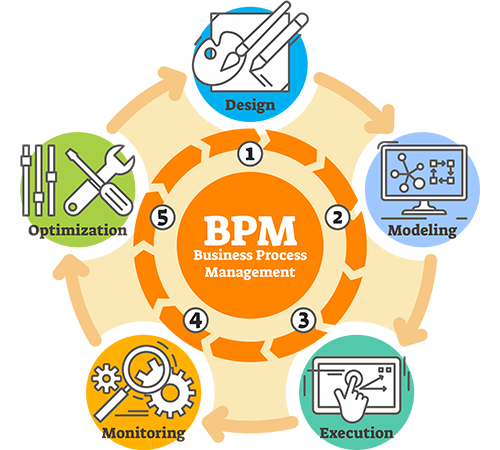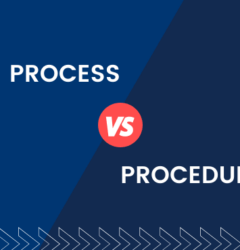
Would you like to optimize your business processes at work to drive efficiency and productivity? What is the right way to do it? Is it BPM or BPA? What is the difference between BPM Vs BPA?
Managing business processes is a major challenge for most companies. The need to streamline business processes has existed for a long time, with high demand for business process management (BPM) and business process automation (BPA) solutions. According to research, the value of the Business Process management market is to grow from $13.38 Billion in 2023 to $23.40 Billion 2027.
In this article, let’s learn about BPM and BPA, their similarities, and their differences.
What is Business Process Management?
BPM is a more comprehensive and wider approach to achieving process efficiency. It does not depend on automation but rather on designing, modeling, deploying, monitoring, and optimizing company-wide business processes. The goal is to gain maximum productivity and efficiency in day-to-day activities.
This is usually implemented as an organization-wide approach. It needs a constant search for new ways to simplify and further improve the workflow of the business.
Also read: Business process management – The what, why, and how
The steps in business process management:

1. Design
Most systems include a data collection method and a workflow to process it. Create your template and decide who will be the owner of every task in the workflow.
2. Model
Represents the mechanism in a visual interface. Fix information such as deadlines and conditions to provide a clear picture of the sequence of events and the flow of data through the process.
3. Execute
Execute the process by testing it live with a smaller group first and then open it to all users. Please make sure that you limit access to confidential information.
4. Monitor
Keep a keen eye on the process as it runs through the workflow. Use the right statistics to identify progress, assess efficiency, and identify problems and bottlenecks.
5. Optimize
As you analyze, notice any changes that need to be made to your form or workflow to make it more efficient. Consider measures to improve the business process.

What is Business Process Automation?
BPA simplifies business processes through technical solutions that automate manual, repetitive tasks. This helps the workforce restructure time to more important issues when routine work is completed in less time through automation.
Business Process Automation concentrates on decreasing the number of manual tasks. This leads to higher efficiency and productivity.
A variety of tools and applications have been developed with this purpose in mind. The risk of human error during processes such as data input is removed, along with other potential obstacles.

Examples of BPA in various business areas:
- Operations Management
- File Transfers Function
- Project Management
- Report Generation and Delivery
- Customer Service
- Social Media and Email Management etc.
Also read: Top 10 Business Process Automation Benefits
BPM Vs BPA: Difference between BPM and BPA
As you have seen, the objectives of both approaches are the same. It’s about improving business operations and getting more value from business processes and workflows.
However, how they go about it differs in both Business Process Management and Business Process Automation.
Also read: BPM and RPA: What’s the difference, and which do you need?
1. Objective
Business process management (BPM) aims to improve process productivity, operational quality, and cost efficiency by providing an overall picture of all workflows included in the business process.
Business process automation (BPA) focuses on automating repetitive manual tasks across a wide range of business processes in the organization.
2. Scope of BPM & BPA
BPM aims to disrupt the process itself to accomplish the goal of improved efficiency and optimization.
Whereas BPA strives to improve efficiency by technical means. It does not change the core of the systems but makes them simpler and more efficient.
3. The time required for the execution
You don’t need to spend as many hours configuring the automation software in Business Process Automation as you will need to process the whole methodology in Business Process Management.
4. Implementation of BPM & BPA
The complexity of implementation is another important difference. The adoption of BPM is a huge effort. You’re likely going to readjust your corporate ideology for yourself and your team.
BPA has a much easier configuration. It often comes as a software/application/device that you only need to customize to suit your needs.
Also Read: Step Into Success With These 7 Business Process Management Examples
5. Importance of Technology
BPM is not confined to technology. Technology is also just one element of many. It also focuses on the company’s methodology, procedure, and ideology.
On the other hand, BPA, a software-based solution, is highly dependent on technology. This transforms manual tasks into automated tasks.
6. Impact of BPM & BPA
The impact of BPM & BPA practices on each situation is often unique. BPA can appear to have less effect at the surface level because it is less complex. Still, that’s not always the case. It’s possible to massively improve the outcome by automating a basic operation.
At the same time, it is not easy to get hold of businesses to completely change their way of doing business through business process management.
Can BPM & BPA work together?
They need to be incorporated together to get the best benefit out of them. Most businesses view BPA tools as a simple solution that can quickly resolve all obstructions without any extra work. However, that may not always be the case.
On the other hand, simply adding business process management (BPM) to your organization without any technical approaches is also short-sighted. Because this approach focuses on optimization, there is no reason to neglect automation tools.
By integrating both BPM and BPA into the organization’s workflow, you can expect to get the best results. Automating time-consuming and labour-intensive work allows working people to concentrate on developing other business operations. At the same time, learning how to take advantage of the time gained by automation is just as crucial. The combination of BPM and BPA should be a priority for each organization.
Conclusion
BPM and BPA, when implemented together effectively, can drive your organization to an extraordinary level of efficiency, deliver the best for your employees and customers, and accelerate time-to-business outcomes.
Quixy is rated a high performer for both BPM and BPA categories in G2. Get started with our platform, and experience the ease of automated processes and personalized app building.
Frequently Asked Questions(FAQs)
Q. How do BPM and BPA contribute to digital transformation initiatives?
BPM and BPA play crucial roles in digital transformation by fostering agility, improving operational efficiency, and leveraging automation technologies. They enable organizations to adapt to technological advancements and changing business landscapes.
Q. How do BPM and BPA complement each other?
BPM and BPA can work synergistically. BPM provides the framework for understanding, managing, and optimizing processes, while BPA focuses on automating specific tasks within those processes, enhancing overall efficiency.
Q. How does BPM contribute to overall business strategy?
BPM aligns business processes with organizational goals, ensuring that workflows are efficient, adaptable, and supportive of strategic objectives. It provides a holistic view of processes for continuous improvement.
Q. Can BPM and BPA improve customer experiences?
Yes, by streamlining processes, reducing turnaround times, and minimizing errors, BPM and BPA contribute to enhanced customer experiences, fostering satisfaction and loyalty.
Q. How does Business Process Automation (BPA) contribute to cost savings?
BPA reduces manual intervention, minimizes errors, and accelerates task completion, leading to cost savings through increased productivity and resource optimization.
Login
Please login to comment
0 Comments
Oldest
















